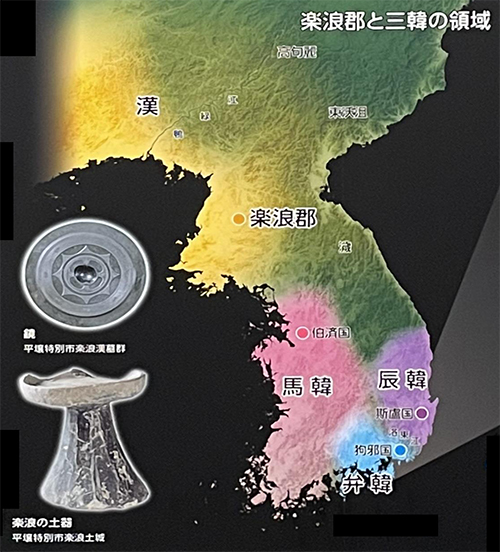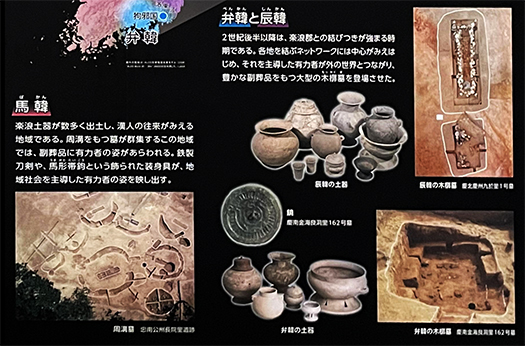


古代の「国際関係」にとって非常に重要な半島地域。
日本列島社会にとってもっとも身近な地域として日本の王権の誕生に
大きな関わりを持っていたに違いないと思うけれど、
そうした関係論の解剖はあまり聞かない。
神武東征の時期が1世紀という説が強くなってくるとすれば
北部九州とこれらの地域との関係性は核心的だとも思える。
この時期の半島社会は、北に楽浪郡とその後その南方に置かれた帯方郡があり
半島南部地域は三韓といわれる時代になっていた。
〜三韓とは1世紀から4世紀にかけての朝鮮半島南部に存在した集団とその地域。
108年朝鮮半島南部に漢の武帝が楽浪郡以下の四郡を置き郡県制の支配を及ぼし、
韓民族もその直接間接の支配を受けた。さらに3世紀には遼東太守公孫氏によって
帯方郡が設けられると帯方郡は三韓さらに海を隔てた倭を含んだ
東アジアのキーステーションの役割を果たした。
●韓民族の国家形成
313年に楽浪郡、翌年帯方郡が北方に急成長した高句麗によって滅ぼされた結果
帯方郡の間接的統治を受けていた韓民族に自立の動きが強まった。
まず馬韓の50余国はその中の一つであった百済によって統合され、
辰韓の12余国は新羅によって統合された。
しかし弁韓の地は加羅など小国家分立が続き、
倭の大和政権も進出した。4世紀以降の朝鮮は三国時代といわれることになる。〜
大陸の独裁権力国家の消長の影響が大きく反映していた。
そういった国際情勢の中で神武は北部九州から東征し本州中部に王権を樹立。
このことは日本列島での「地政学」的には妥当性が高い動き。
しかし一方では半島−九州北部地域の方がはるかに先進地域。
白村江の海戦は西暦663年8月27日。これを沸騰点として
半島と列島の社会は非常に密接に関係して連動していたと思われる。
現代のわれわれは国家の存在を無意識の前提にして歴史を考えるけれど、
朝鮮半島の政治的緊張に対して海外派兵を決断するというのは
かなりの飛躍のある考え方だと思える。
それほどの半島南部社会との強い関係性があって決断したのだろう。
普通に考えれば、それはひとつの沸騰点であってむしろ日常的に
強い結びつきがあってその延長線上で派兵があったと考える方が自然。
また、白村江敗戦はちょうど戦後社会の大転換のような要素を
日本社会にもたらしたとも思える。
百済の臣民たちが大挙して列島に移動してきたことで王権が強化もされた。
祭政のレベルがそれを契機として一気に加速したことがわかる。
English version⬇
What was the “Three Hans” Peninsula Region in the 1st Century? The 37,000-Year History of the Japanese Archipelago – 41]
During the period of 600 years between the Shinmu Expedition and the Battle of Hakuchon River in 663, the unified government of Japan was born and had a strong relationship with the peninsular society. …
The peninsula region is very important for “international relations” in ancient times.
It must have had a great deal to do with the birth of Japanese kingship as the region closest to the Japanese archipelago society.
I think it must have had a great deal to do with the birth of the Japanese kingship.
However, we do not hear much dissection of such a relationship.
If the theory of the first century is strengthened, the relationship between northern Kyushu and these regions is not so clear.
The relationship between northern Kyushu and these regions seems to be the core of the theory.
The society of the peninsula during this period consisted of Raknami-gun in the north and later Obihang-gun to the south of Raknami-gun.
The southern region of the peninsula was known as Sanhan.
〜The three Han are the groups and regions that existed in the southern part of the Korean Peninsula from the 1st to 4th centuries.
In 108, Emperor Wu of the Han Dynasty established four counties under Naknang-gun in the southern part of the Korean Peninsula and ruled it under the county and prefecture system.
The Han people were also ruled directly or indirectly by the Wudang. In the 3rd century, Gongsun, the governor of Liaodong
Bifang-gun was established by Gongsun, the governor of Liaodong in the 3rd century, and played the role of a key station in East Asia
The county played the role of a key station in East Asia, including the three Koreas and Japan, which was located across the sea.
Formation of the Han Nation
After the destruction of Yeoknam-gun in 313 and Obihang-gun the following year by the rapidly growing Goguryeo Dynasty in the north
The indirect rule of Bihang-gun led to a growing movement toward self-reliance among the Han people.
First, the 50-odd states of Mahan were united by Baekje, which was one of the 50-odd states of Mahan.
The 12 countries of the Jinhan region were united by Silla. However, the division of small states continued in Benhan, such as Kara, and the Yamato regime of Japan also moved in.
From the 4th century onward, Korea was known as the Three Kingdoms Period. 〜The fourth century onward, Joseon became known as the Three Kingdoms Period.
The influence of the dissipation of dictatorial powers on the continent was greatly reflected in the Joseon Dynasty.
In such an international situation, Jinmu conquered the east from northern Kyushu and established a royal authority in the central part of Honshu.
This was a highly appropriate move in terms of “geopolitics” in the Japanese archipelago.
On the other hand, however, the Peninsula – northern Kyushu region is a much more advanced region.
The Battle of Hakumura-jiang was on August 27, 663 AD. This was the boiling point.
Peninsular and archipelagic societies seem to have been very closely related and interlocked.
Today, we think of history based on the unconscious assumption of the existence of a nation.
But the decision to deploy troops overseas in response to political tensions on the Korean peninsula seems to me to be a considerable leap of faith.
It is quite a leap of faith.
The decision must have been based on such a strong relationship with the society in the southern part of the peninsula.
Normally, this would be a boiling point, but it is more likely that the decision was made because of the strong ties that exist between the two Koreas on a day-to-day basis.
It is more natural to think that there were strong ties between the two countries on a daily basis, and that the deployment of troops was an extension of those ties.
The defeat at the Hakuchon River also seems to have brought about a major social change in postwar Japan.
The defeat at Baekchonjiang brought about a major shift in Japanese society in the postwar period.
The large number of Baekje subjects who moved to the archipelago also strengthened the royal authority.
The level of ritual government was accelerated by this event.
Posted on 12月 12th, 2022 by 三木 奎吾
Filed under: 日本社会・文化研究, 歴史探訪







コメントを投稿
「※誹謗中傷や、悪意のある書き込み、営利目的などのコメントを防ぐために、投稿された全てのコメントは一時的に保留されますのでご了承ください。」
You must be logged in to post a comment.